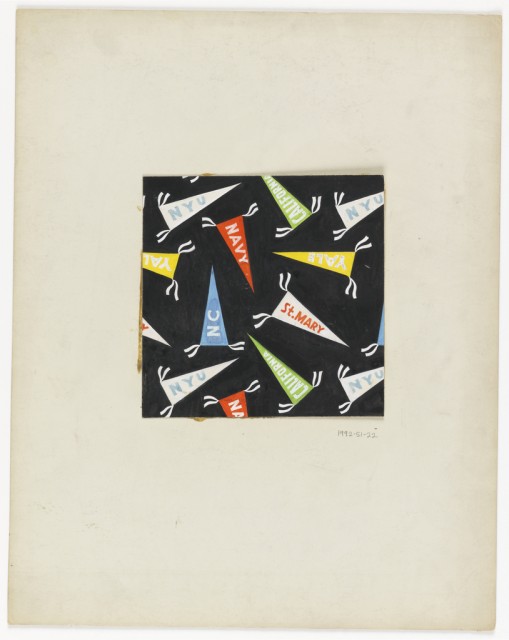There is no evidence that Tommi Parzinger’s textile design of collegiate banners was ever produced. Nevertheless, the brightly-colored red, blue, yellow and green flags speak to both the designer’s aesthetic and the time period. Throughout the postwar 1950s, as Parzinger’s career in New York took off, a wave of college spirit swept the United States.
Color was essential aspect of Parzinger’s aesthetic, from fabrics and wallpaper to furniture. In 1950, Parzinger introduced a new collection of home furnishings for his company, Parzinger Originals, that featured brightly colored fabrics, including one called Tutti-Frutti—the name alone evokes the type of colors used. In addition, in 1954, Parzinger decorated a home for the architect Rudolph Matern in Plainview, Long Island, in which he primarily used the colors red, yellow, and blue, including furniture painted to match. His eye for color was so highly regarded that the home construction firm, Morton Brothers, specifically mentioned Parzinger in advertisements for Morton Village homes as their designer on retainer, the one responsible for every detail of color coordination and exterior styling.
Chances are, most of the people buying “Parzinger approved” Morton Village homes were recent college graduates. From the end of World War II until the 1970s, more Americans went to college than ever before. This was the direct result of fives factors: the G. I. Bill, the Cold War, the Baby Boom, the rise in junior/community colleges, and the increase in financial aid for higher education. In 1944, in response to the high number of military personnel returning to the domestic economy, Congress passed the G. I. Bill to provide funds for returning veterans to go to college. In 1947, largely due to the escalation of the Cold War, the President’s Commission on Higher Education in a Democracy determined that federal funding of research should continue, even in peacetime. This led to funding for advanced studies in foreign languages, anthropology, and political science as well as the sciences, specifically physics and chemistry. As the concept of going to college became more widely accepted, campuses and class sizes expanded to accommodate Baby Boomer enrollment. By the 1960s, the government also began to provide low-priced continuing and locally-accessible education through junior and community colleges. In the 1970s, state and local government began to reduce the tuition rates of state colleges, while the Federal government extended financial aid through the Education Amendments of 1972. These fives factors set an ever-increasing number of Americans on the path to college.
Perhaps it is this new college spirit that Parzinger illustrates in his own colorful style, through the depiction of collegiate banners from across the country.
